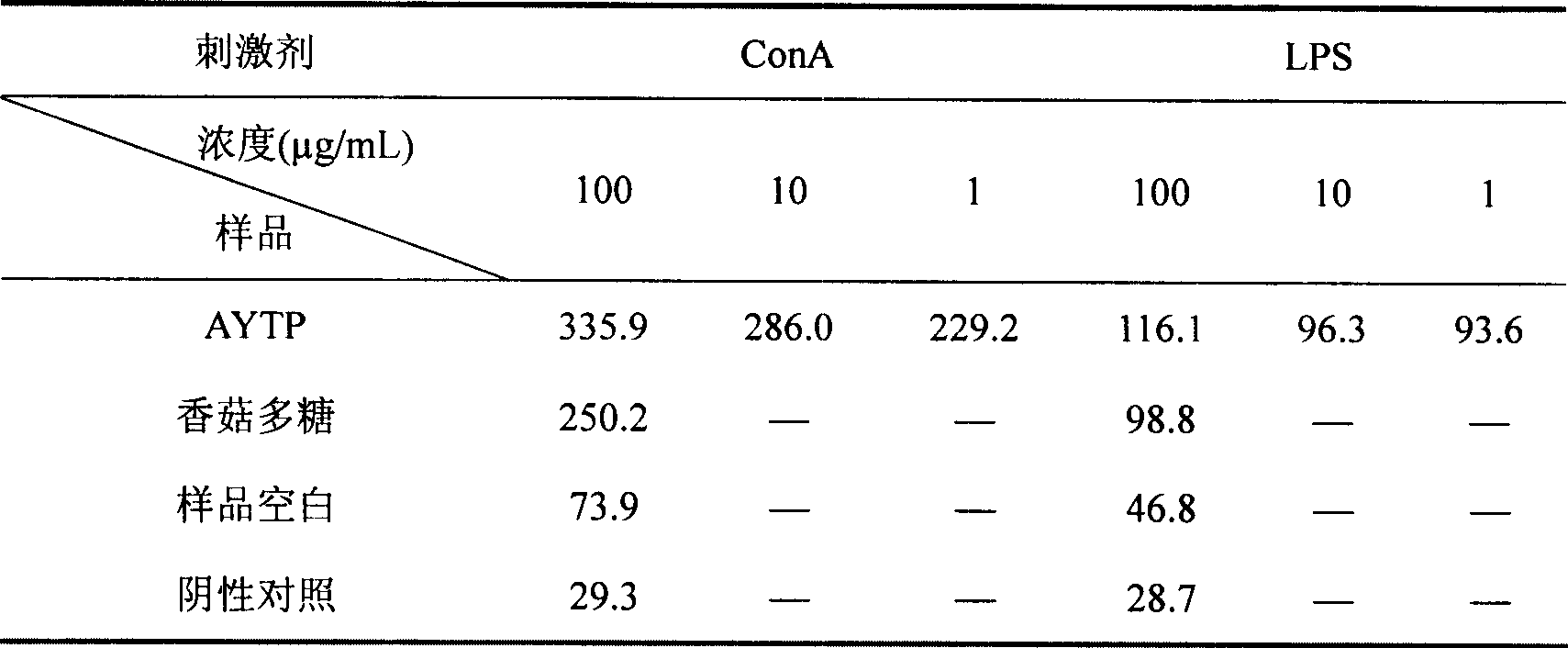Use of argyi leaf polysaccharide extract
A technology of polysaccharide extraction and precipitation, which is applied in the field of polysaccharide extract from leaves of Artemisia argyi, and can solve the problems of unreported use of polysaccharide extract from leaves of Artemisia argyi
- Summary
- Abstract
- Description
- Claims
- Application Information
AI Technical Summary
Problems solved by technology
Method used
Image
Examples
Embodiment 1
[0018] Take 2.0kg of Artemisia argyi leaves, decoct and extract twice, each time for 1 hour, add 10 times the amount of water each time, and combine the two filtrates. The filtrate was concentrated to 500 mL at 50°C under reduced pressure, and ethanol was added to make the concentration 65v / v%. After standing for 12 hours, it was centrifuged for 20 minutes, the supernatant was discarded, and the precipitate was dried under reduced pressure at 50°C. Mix the dried precipitate with 400mL of deionized water, then add 200mL of 10wt% trichloroacetic acid solution, stir well, leave it for 4 hours, centrifuge for 20 minutes, discard the precipitate, and add ethanol to the clear liquid to make the concentration 75v / v%, ethanol precipitation (standing) for 24 hours and then centrifuged to obtain the precipitate, which was washed with absolute ethanol, acetone, and ether in sequence, and then vacuum-dried at 50°C to obtain 24g of Artemisia argyi polysaccharide extract.
Embodiment 2
[0020] Take 2.0kg of Artemisia argyi leaves, decoct and extract twice, each time for 1 hour, add 10 times the amount of water each time, and combine the two filtrates. The filtrate was concentrated under reduced pressure at 50°C to 500mL, and ethanol was added to make the concentration 80v / v%, after standing for 12 hours, centrifuged for 20 minutes, the supernatant was discarded, and the precipitate was dried under reduced pressure at 50°C. The dried precipitate was mixed with 400 mL of deionized water, and deproteinized by the Sevag method for a total of 7 treatments. Add ethanol to the supernatant obtained after deproteinization by the Sevag method to make the concentration 75v / v%. After alcohol precipitation (standstill) for 24 hours, it is centrifuged to obtain the precipitate, and the resulting precipitate is washed with absolute ethanol and acetone successively. , and ether, and then vacuum-dried at 50° C. to obtain 38 g of Artemisia argyi polysaccharide extract.
[002...
Embodiment 3
[0023] The inhibitory effect of intravenous injection of Artemisia argyi polysaccharide extract (abbreviation: AYTP) extracted by the extraction method described in Example 1 on mouse transplanted tumor Heps:
[0024] Take 40 ICR mice (18-22g, half male and half female; provided by the Shanghai Experimental Animal Center of the Chinese Academy of Sciences), inoculate Heps solid type according to the transplanted tumor research method, weigh the mice 24 hours after inoculation, and divide them into 4 groups randomly. There were 10 rats in each group, half male and half male, and the blank control group and the cyclophosphamide (CTX, 30 mg / kg) group were respectively yin and yang control groups. AYTP group set up high and low dose groups (100, 50mg / kg). 24 hours after inoculation, intravenous injection was administered, once every other day, and a total of 4 administrations were administered. On the second day after drug withdrawal, the mice were weighed, and the tumor-bearing m...
PUM
 Login to View More
Login to View More Abstract
Description
Claims
Application Information
 Login to View More
Login to View More - R&D
- Intellectual Property
- Life Sciences
- Materials
- Tech Scout
- Unparalleled Data Quality
- Higher Quality Content
- 60% Fewer Hallucinations
Browse by: Latest US Patents, China's latest patents, Technical Efficacy Thesaurus, Application Domain, Technology Topic, Popular Technical Reports.
© 2025 PatSnap. All rights reserved.Legal|Privacy policy|Modern Slavery Act Transparency Statement|Sitemap|About US| Contact US: help@patsnap.com



